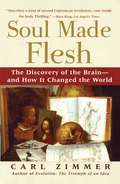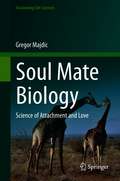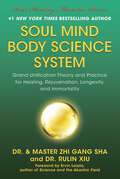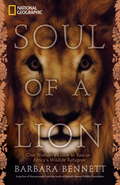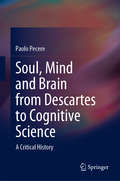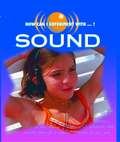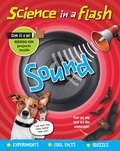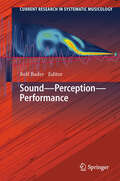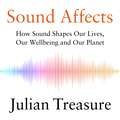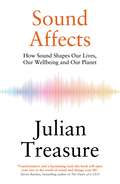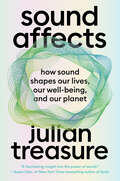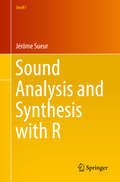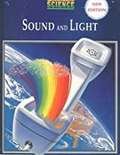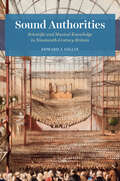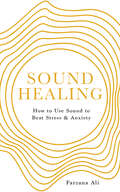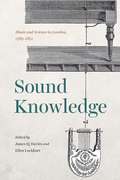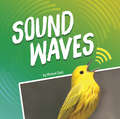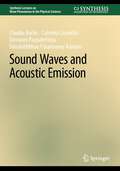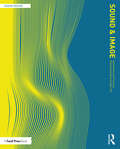- Table View
- List View
Soul Made Flesh: The Discovery of the Brain--and How it Changed the World
by Carl ZimmerIn this unprecedented history of a scientific revolution, award-winning author and journalist Carl Zimmer tells the definitive story of the dawn of the age of the brain and modern consciousness. Told here for the first time, the dramatic tale of how the secrets of the brain were discovered in seventeenth-century England unfolds against a turbulent backdrop of civil war, the Great Fire of London, and plague. At the beginning of that chaotic century, no one knew how the brain worked or even what it looked like intact. But by the century's close, even the most common conceptions and dominant philosophies had been completely overturned, supplanted by a radical new vision of man, God, and the universe. Presiding over the rise of this new scientific paradigm was the founder of modern neurology, Thomas Willis, a fascinating, sympathetic, even heroic figure at the center of an extraordinary group of scientists and philosophers known as the Oxford circle. Chronicled here in vivid detail are their groundbreaking revelations and the often gory experiments that first enshrined the brain as the physical seat of intelligence -- and the seat of the human soul. Soul Made Flesh conveys a contagious appreciation for the brain, its structure, and its many marvelous functions, and the implications for human identity, mind, and morality.
Soul Mate Biology: Science of attachment and love (Fascinating Life Sciences)
by Gregor MajdicLove, one of the most profound of human emotions, love that accompanies us from puberty to old age, love that follows us from ancient times to modern, from ancient writings, through the Bible and the texts of medieval scribes to modern day books and movies. Through the millennia love has lost none of its secrecy, charm, attractiveness, craziness, even in this digital age, when we are overwhelmed by information.But what is love? Where does this emotion originate? Are we humans the only living beings feeling this emotion? Can love be explained by some chemical reactions in our brains? Is love just a trick of nature or is love some kind of higher feeling? We do not have definite answers to any of these questions, nevertheless, neuroscience, behavioral science and others have provided us with some, at least partial answers. We know today a great deal more than ever before about what is happening in the brain when we are madly in love. We understand why our hearts beat faster when we see the person we love, we know why we sweat and why we feel anxious when the loved one is away from us, and we have some ideas about how feelings of attachment form in the brain. This book guides you through the complicated labyrinth of genes, molecules and brain cells that are involved in the feelings of love, attachment, affection, and also simple sexual reproduction.
Soul Mind Body Science System: Grand Unification Theory and Practice for Healing, Rejuvenation, Longevity, and Immortality
by Zhi Gang ShaWhat is a soul? Are miracles real? When the soul is healed, how does the body respond? Throughout history, there have been countless cases of "miracle" healings, unexplainable by modern science. Dr. and Master Zhi Gang Sha has personally healed thousands of patients, usually in front of dozens of witnesses. Hundreds of videos of these healings can be seen on YouTube. But how can these healings be explained? Soul Mind Body Science System is the first book to explore the scientific explanations for why soul healing miracles are genuine. Written with Dr. Rulin Xiu, an expert on string theory and quantum physics who trained at The University of California, Berkeley, Dr. Sha shares, for the first time, the scientific theories that explain why all actions on Earth are guided by the reality of the soul. In Soul Mind Body Science System, the complex and fascinating relationships present between matter, density, information, soul, and consciousness are thoroughly examined. Written for armchair and professional scientists alike, this book makes a significant contribution to the ongoing debate about the true nature of reality. As the lines between "science" and "spirit" blur, this investigation becomes ever more important. The groundbreaking Soul Mind Body Science System is for all readers who have contemplated the fundamental scientific laws of the universe and sought answers beyond those offered by popular science and mainstream faith.
Soul of a Lion: One Woman's Quest to Rescue Africa's Wildlife Refugees
by Barbara BennettIt chronicles the unique Harnas Wildlife Foundation in Namibia, where Marieta van der Merwe and her family, former wealthy cattle farmers, have sold land to buy and care for embattled wildlife.
Soul, Mind and Brain from Descartes to Cognitive Science: A Critical History
by Paolo PecereThis interdisciplinary book ties the historical work of Descartes to his successors through current research and critical overviews on the neuroscience of consciousness, the brain, and cognition. This text is the first historical survey to focus on the cohesions and discontinuities between historical and contemporary thinkers working in philosophy, physiology, psychology, and neuroscience.The book introduces and analyzes early discussions of consciousness, such as: metaphysical alternatives to scientific explanations of consciousness and its connection to brain activity; claims about the possibilities and limits of neuroscientific accounts of consciousness and cognition; and the proposition of a “non-reductive naturalism” concerning phenomenal consciousness and rationality. The author assesses the contributions of early philosophers and scientists on brain, consciousness and cognition, among them: Descartes, Malebranche, Spinoza, Leibniz, Locke, Newton, Haller, Kant, Fechner, Helmholtz and du Bois-Reymond. The work of these pioneers is related to that of modern researchers in physiology, psychology, neuroscience and philosophy of mind, including: Freud, Hilary Putnam, Herbert Feigl, Gerald Edelman, Jean-Pierre Changeux, Daniel Dennett and David Chalmers, amongst others. This text appeals to researchers and advanced students in the field.
Soul: God, Self and the New Cosmology
by Angela TilbyThe Scientists and Theologians who play parts inSoul: God, Self and the New Cosmology: •Stephen Hawking •Matthew Fox •Ilya Prigogine •Paul Davies •John Polkinghorne •David Griffin •John Rodwell •David Schramm •Rowan Williams •Brian Swimme •Alan Guth •Steven Weinberg •Frank Tipler •Arnold Mandell •Roger Penrose •Danah Zohar •Thomas Berry
Sound (How Can I Experiment With...?)
by Cindy Devine DaltonExplains sound, what our ears do, and what frequency sounds good. Other books in this series are available in this library.
Sound (Science in a Flash #26)
by Georgia Amson-BradshawHelp kids discover science - in a flash!Have you heard all about SOUND? This book contains everything you need to know about echoes, information about infrasound, notes about musical notes and more, so listen up! Science in a Flash: Sounds looks at what sound is, how it is made and what it is used for. Vibrations, music and animal hearing are also covered.This essential KS2 series covers all the key science topics in energetic, quick-fire way, aiding clear comprehension by getting straight to the point! Each spread starts with a 'flash' or headline, summing-up succinctly the science information to follow. Attractive and light-hearted illustration visually conveys the information, adding depth and detail to engage children. Also includes fun jokes and cartoons to keep even the most reluctant readers entertained.
Sound - Perception - Performance
by Rolf BaderMusical Performance covers many aspects like Musical Acoustics, Music Psychology, or motor and prosodic actions. It deals with basic concepts of the origin or music and its evolution, ranges over neurocognitive foundations, and covers computational, technological, or simulation solutions. This volume gives an overview about current research in the foundation of musical performance studies on all these levels. Recent concepts of synchronized systems, evolutionary concepts, basic understanding of performance as Gestalt patterns, theories of chill as performance goals or historical aspects are covered. The neurocognitive basis of motor action in terms of music, musical syntax, as well as therapeutic aspects are discussed. State-of-the-art applications in performance realizations, like virtual room acoustics, virtual musicians, new concepts of real-time physical modeling using complex performance data as input or sensor and gesture studies with soft- and hardware solutions are presented. So although the field is still much larger, this volume presents current trends in terms of understanding, implementing, and perceiving performance.
Sound Affects: How Sound Shapes Our Lives, Our Wellbeing and Our Planet
by Julian Treasure'Transformative and a fascinating read; this book will open your ears to the world of sound and change your life' Steven Bartlett, bestselling author of The Diary of a CEO'A fascinating insight into the power of sound' Susan Cain, No. 1 New York Times bestselling author of QUIETEvery day, the sounds around us affect every aspect of our human experience, and thus fundamentally alter our quality of life, for better or worse. It is only recently that scientists have realised that sounds connect us to the world in ways that are every bit as vivid and evocative as visual landscapes. Hearing is the first sense we develop, and as our primary warning sense it is hardwired into our brains. And yet, in an increasingly noisy and distracted world, most people pay scant attention to the sounds around them, causing them to lose contact with the essential skill of listening. Sound Affects is about rediscovering the wonder of sound, and understanding how powerfully it affects us, whether we are paying attention or not. It is also a manual for taking back responsibility for the sounds we consume and the sounds we make, so we can enhance our own happiness, effectiveness and well-being.In the process, the reader will discover that:- stars are like bells, ringing with sound black holes make sound 50 octaves below what we can hear - snapping shrimp may be only 1cm long but they make sound that's as loud as a rock concert - whales can communicate underwater over hundreds of miles with very low frequency sound that travels five times as fast as sound in air - individual cells make unique sounds, enabling scientists detect early signs of metastases - dolphins have names and call each other by them
Sound Affects: How Sound Shapes Our Lives, Our Wellbeing and Our Planet
by Julian Treasure'Transformative and a fascinating read; this book will open your ears to the world of sound and change your life' Steven Bartlett, bestselling author of The Diary of a CEO'A fascinating insight into the power of sound' Susan Cain, No. 1 New York Times bestselling author of QUIETEvery day, the sounds around us affect every aspect of our human experience, and thus fundamentally alter our quality of life, for better or worse. It is only recently that scientists have realised that sounds connect us to the world in ways that are every bit as vivid and evocative as visual landscapes. Hearing is the first sense we develop, and as our primary warning sense it is hardwired into our brains. And yet, in an increasingly noisy and distracted world, most people pay scant attention to the sounds around them, causing them to lose contact with the essential skill of listening. Sound Affects is about rediscovering the wonder of sound, and understanding how powerfully it affects us, whether we are paying attention or not. It is also a manual for taking back responsibility for the sounds we consume and the sounds we make, so we can enhance our own happiness, effectiveness and well-being.In the process, the reader will discover that:- stars are like bells, ringing with sound black holes make sound 50 octaves below what we can hear - snapping shrimp may be only 1cm long but they make sound that's as loud as a rock concert - whales can communicate underwater over hundreds of miles with very low frequency sound that travels five times as fast as sound in air - individual cells make unique sounds, enabling scientists detect early signs of metastases - dolphins have names and call each other by them
Sound Affects: How Sound Shapes Our Lives, Our Wellbeing and Our Planet
by Julian TreasureA "fascinating" narrative that takes readers on an epic journey spanning disciplines, continents, and centuries that spotlights sound's incredible impact on our bodies, feelings, thinking, and behavior (Susan Cain, bestselling author of Quiet). Hearing is the first sense we develop—a primary warning instinct hardwired into our brains. And yet, in an increasingly noisy and distracted world, most people pay very little attention to sound. In school, we teach reading and writing, but not listening. Conscious listening is rare, and, with over half the world's population now living in cities, billions of people never experience the rich and health‑enhancing sounds of the natural world. Every day, the sounds around us affect our experience and fundamentally alter our quality of life, for better or worse. In four sections—geophony, the sounds of the planet; biophony, the "great animal orchestra"; anthropophony, the sounds of humanity; and silence, a sound in its own right—this book will help readers rediscover the wonder of sound and understand how powerfully it affects us, whether we're paying attention or not. It will also offer readers a manual for taking back responsibility for the sounds we consume and the sounds we make, so we can enhance our own happiness.
Sound Analysis and Synthesis with R (Use R!)
by Jérôme SueurSound is almost always around us, anywhere, at any time, reaching our ears and stimulating our brains for better or worse. Sound can be the disturbing noise of a drill, a merry little tune sung by a friend, the song of a bird in the morning or a clap of thunder at night. The science of sound, or acoustics, studies all types of sounds and therefore covers a wide range of scientific disciplines, from pure to applied acoustics. Research dealing with acoustics requires a sound to be recorded, analyzed, manipulated and, possibly, changed. This is particularly, but not exclusively, the case in bioacoustics and ecoacoustics, two life sciences disciplines that attempt to understand and to eavesdrop on the sound produced by animals. Sound analysis and synthesis can be challenging for students, researchers and practitioners who have few skills in mathematics or physics. However, deciphering the structure of a sound can be useful in behavioral and ecological research – and also very amusing. This book is dedicated to anyone who wants to practice acoustics but does not know much about sound. Acoustic analysis and synthesis are possible, with little effort, using the free and open-source software R with a few specific packages. Combining a bit of theory, a lot of step-by-step examples and a few cases studies, this book shows beginners and experts alike how to record, read, play, decompose, visualize, parametrize, change, and synthesize sound with R, opening a new way of working in bioacoustics and ecoacoustics but also in other acoustic disciplines.
Sound And Light (Prentice Hall Science Integrated Learning System)
by Prentice-Hall StaffPrentice Hall Science: Sound and Light
Sound Authorities: Scientific and Musical Knowledge in Nineteenth-Century Britain
by Edward J. GillinSound Authorities shows how experiences of music and sound played a crucial role in nineteenth-century scientific inquiry in Britain. In Sound Authorities, Edward J. Gillin focuses on hearing and aurality in Victorian Britain, claiming that the development of the natural sciences in this era cannot be understood without attending to the study of sound and music. During this time, scientific practitioners attempted to fashion themselves as authorities on sonorous phenomena, coming into conflict with traditional musical elites as well as religious bodies. Gillin pays attention to sound in both musical and nonmusical contexts, specifically the cacophony of British industrialization. Sound Authorities begins with the place of acoustics in early nineteenth-century London, examining scientific exhibitions, lectures, spectacles, workshops, laboratories, and showrooms. He goes on to explore how mathematicians mobilized sound in their understanding of natural laws and their vision of a harmonious ordered universe. In closing, Gillin delves into the era’s religious and metaphysical debates over the place of music (and humanity) in nature, the relationship between music and the divine, and the tensions between spiritualist understandings of sound and scientific ones.
Sound Authorities: Scientific and Musical Knowledge in Nineteenth-Century Britain
by Edward J. GillinSound Authorities shows how experiences of music and sound played a crucial role in nineteenth-century scientific inquiry in Britain. In Sound Authorities, Edward J. Gillin focuses on hearing and aurality in Victorian Britain, claiming that the development of the natural sciences in this era cannot be understood without attending to the study of sound and music. During this time, scientific practitioners attempted to fashion themselves as authorities on sonorous phenomena, coming into conflict with traditional musical elites as well as religious bodies. Gillin pays attention to sound in both musical and nonmusical contexts, specifically the cacophony of British industrialization. Sound Authorities begins with the place of acoustics in early nineteenth-century London, examining scientific exhibitions, lectures, spectacles, workshops, laboratories, and showrooms. He goes on to explore how mathematicians mobilized sound in their understanding of natural laws and their vision of a harmonious ordered universe. In closing, Gillin delves into the era’s religious and metaphysical debates over the place of music (and humanity) in nature, the relationship between music and the divine, and the tensions between spiritualist understandings of sound and scientific ones.
Sound Healing: How to Use Sound to Beat Stress and Anxiety
by Farzana AliAn accessible guide to the next big thing in self-care: sound healing. Taking a science-based approach, it provides lessons and exercises to beat stress and anxiety.Discover how sound can help you overcome stress and anxietyTaking a science-based approach which explores the impact of sound on your body and mind, popular sound healer Farzana Ali presents this accessible guide to using sound for self-care.We already use sound as a form of healing, from self-soothing with music to immersing ourselves with the noises of nature to promote calm. This book provides the natural next step, showing you how to realize the many benefits of working with sound, from better sleep to pain management, and from dealing with stress to reducing anxiety.Farzana shares practical tips and everyday activities with advice on extra tools, including active listening, art therapy, breath work, journaling exercises and visualizations. It also provides access to a sound healing recording that you can use for your practice, delivering the therapeutic potential of sound for whenever you need it most.
Sound Knowledge: Music and Science in London, 1789-1851
by James Q. Davies Ellen LockhartWhat does it mean to hear scientifically? What does it mean to see musically? This volume uncovers a new side to the long nineteenth century in London, a hidden history in which virtuosic musical entertainment and scientific discovery intersected in remarkable ways. Sound Knowledge examines how scientific truth was accrued by means of visual and aural experience, and, in turn, how musical knowledge was located in relation to empirical scientific practice. James Q. Davies and Ellen Lockhart gather work by leading scholars to explore a crucial sixty-year period, beginning with Charles Burney’s ambitious General History of Music, a four-volume study of music around the globe, and extending to the Great Exhibition of 1851, where musical instruments were assembled alongside the technologies of science and industry in the immense glass-encased collections of the Crystal Palace. Importantly, as the contributions show, both the power of science and the power of music relied on performance, spectacle, and experiment. Ultimately, this volume sets the stage for a new picture of modern disciplinarity, shining light on an era before the division of aural and visual knowledge.
Sound Scattering on Spherical Objects
by Tom RotherThis book introduces readers to scattering from a practical/numerical point of view. The focus is on basic aspects like single scattering, multiple scattering, and whether inhomogeneous boundary conditions or inhomogeneous scatterers have to be taken into account. The powerful T-matrix approach is explained in detail and used throughout the book, and iterative solution methods are discussed. In addition, the book addresses appropriate criteria for estimating the accuracy of numerical results, as well as their importance for practical applications. Python code is provided with each chapter, and can be freely used and modified by readers. Moreover, numerous scattering results for different configurations are provided for benchmarking purposes. The book will be particularly valuable for those readers who plan to develop their own scattering code, and wish to test the correct numerical implementation of the underlying mathematics.
Sound Waves (Waves in Motion)
by Michael DahlBirds chirp. A dog barks. Thunder claps. We hear sounds all around us. But how? Sound waves travel through the air, but we don't see them. With engaging, at-level text and colorful images, readers will learn about sound waves and how we use them every day.
Sound Waves and Acoustic Emission (Synthesis Lectures on Wave Phenomena in the Physical Sciences)
by Claudia Barile Caterina Casavola Giovanni Pappalettera Vimalathithan Paramsamy KannanThe nature of sound is, nowadays, well known and understood so that sound could be synthetically described like the propagation of vibration in elastic media.Sound waves propagate as longitudinal waves, transverse waves, or in mixed modes in different media. The development of applications related to the proper management of the information connected with sound waves. This is the case of so-called acoustic emission. This book introduces the basics of sound waves, their types, propagation in different modes, velocities, and other properties It also introduces the basics of acoustic emission and the different sources of acoustic emission. This book delivers different propagation modes, their significance, and the attenuation and distortion of acoustic waves. One of the overlooked applications of acoustic emission, the acousto-ultrasonic approach is introduced and discussed with practical applications.
Sound and Image: Aesthetics and Practices (Sound Design)
by Andrew Knight-HillSound and Image: Aesthetics and Practices brings together international artist scholars to explore diverse sound and image practices, applying critical perspectives to interrogate and evaluate both the aesthetics and practices that underpin the audiovisual. Contributions draw upon established discourses in electroacoustic music, media art history, film studies, critical theory and dance; framing and critiquing these arguments within the context of diverse audiovisual practices. The volume’s interdisciplinary perspective contributes to the rich and evolving dialogue surrounding the audiovisual, demonstrating the value and significance of practice-informed theory, and theory derived from practice. The ideas and approaches explored within this book will find application in a wide range of contexts across the whole scope of audiovisuality, from visual music and experimental film, to narrative film and documentary, to live performance, sound design and into sonic art and electroacoustic music. This book is ideal for artists, composers and researchers investigating theoretical positions and compositional practices which bring together sound and image.
Sound and Light (Science Explorer)
by The Editors at the Prentice HallLearn more about sound and light through these interesting experiments!
